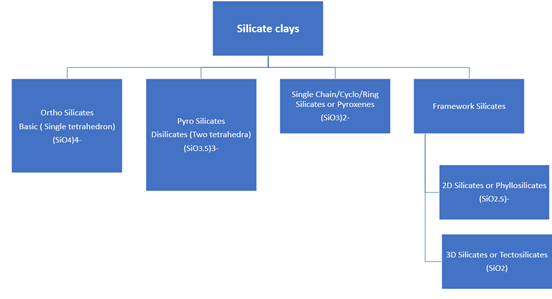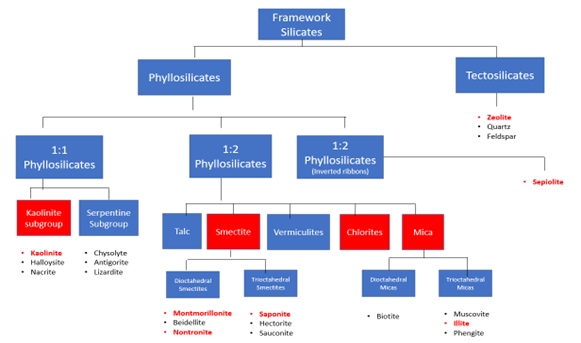TOXIN BINDER CLAYS

TOXIN BINDER CLAYS: UNRAVELLING THE EVOLUTIONARY JOURNEY & NOMENCLATURE
Dr. Rajib Upadhyaya
Product Manager (AMA portfolio)
Cargill India
The animal feed industry uses a wide range of inorganic compounds, collectively referred to as clays, as toxin binders. We always wondered where and how we get these clays? It’s always been a grey area for us even though it is most talked about. Let’s examine and demystify the topic by telling a tale about its emergence, widespread use, effectiveness, and other factors.
Clay is a type of heavy soil that has magical properties, and it is a learned scientist of its own. When wet, it is sticky and mushy & when dried or heated, it is hard. The first ever ceramic substance discovered is nothing but Clay.
Clay is inherently inorganic and a product of natural mines. They are simply endowed with a variety of innate qualities by the earth, which carves them into its crust. There are around 90 elements in the earth’s crust, but only a few are necessary to create soil, rocks, and minerals. Some “non-silicate” minerals, such as carbonates, oxides, halides, sulphites, etc., are composed of these elements but are not the subject of our discussion today. We’ll discuss about the remaining 90% of the earth’s crust, which has the highest concentration of silicon.
The form of silicon that is present in the crust of the earth is silicon dioxide, usually referred to as “quartz” (SiO2). Why is silicon dioxide so common? Because it may easily combine with other substances to create “Silicates,” which is where its career as an adsorbent begins.
Silicon Dioxide bonds very easily with native minerals, aluminium & we get our next abundant constituent, the “Aluminosilicates”. Silicon dioxide (Silicates) together with Sodium & Potassium forms Sodium silicate or Potassium silicate commonly known as “Feldspar” (an important ingredient of drinking glasses & windowpanes). Let’s walk through the classification of Silicates & further Aluminosilicates in brief.
Silicates and Aluminosilicates:
A basic silicate is a mineral containing silicon & oxygen in tetrahedral (SiO4) 4- units, which are linked together in different patterns.
We categorise these silicates using names that reflect the diverse forms they take on when numerous of them align. (classification I)

The formation of HSCAS:
The SiO2 (or Silicate) always react with one or the other metal cations like Sodium, to form Sodium Silicate (Na2SiO3), with Calcium to form Calcium Silicate (Ca2SiO4), Magnesium to form Magnesium Silicate (MgSiO3), Potassium to form Potassium Silicates (K2O3Si) or Aluminium to form Aluminium silicate, commonly, Aluminosilicates. Aluminosilicates may be hydrated or anhydrous, which may occur in nature as minerals or may be synthetically produced for commercial purpose. When aluminosilicates occur with one or more cation, like sodium and calcium, we call them, Sodium Calcium Aluminosilicates, when it in hydrated, it is named Hydrated Sodium Calcium Aluminosilicates (HSCAS), sometimes they are known as hydrated Bentonites and commonly as Zeolites.
Further the framework silicates, the 2D silicates with plate like arrangement or phyllosilicates and the 3D Silicates or net like arrangement or tectosilicates (Classification I) along with metal cations are broadly used as clays for toxin binding and can be further classified as follows.
Some phyllosilicates possess coordinated positions with two of the octahedral sites occupied by metal cations are called Dioctahedral phyllosilicates and the phyllosilicates with three octahedral sites occupied by metal cations are called Trioctahedral phyllosilicates. Now, when one tetrahedral sheet for each octahedral sheet represents 1:1 Phyllosilicates and similarly when one tetrahedral sheet is for two octahedral sheets represents 1:2 Phyllosilicates. These ratios represent the number of cations that the clay or phyllosilicates can acquire and is associated with the CEC value of the clay. CEC, Cation Exchange Capacity of a clay is a property determines its efficacy in sequestering polar toxins. CEC becomes more important when selecting the clays as a toxin binder and the extent to which they can spare the essential nutrients in animal feed. Various silicates highlighted in classification II are among the most suitable clays that are commonly used in animal feed to bind various toxins.
The nomenclature story of clays:
We often come across various names that are associated with the clays, the very common being the Bentonite. Let’s unravel how these names are being conferred. “Bentonite” has got its name from the place, Fort Benton, in Montana state of the USA, where it was discovered. Bentonite is typically a name given to the phyllosilicate of Smectite class that is predominantly a Montmorillonite, as classified. Bentonites are the one of the first rocky formations of swelling type of clays. (Informativa E Prestazione DCASD 196/2003). Similarly, “Montmorillonite” got its name from the place, Montmorillonite, a commune in France, where it was discovered. Whereas, by classification it is a Smectite clay which is dioctahedral in its structure. In nature Montmorillonite occur along with metal cations like Sodium and Calcium, and often identified as Na-Montmorillonite and Ca-Montmorillonite. Further, Saponite, a phyllosilicate of smectite class, got its name from Latin sapon, meaning soap, because of its appearance and ability to clean. The name “Kaolinite”, a phyllosilicate, got its name after the Kao-ling, a mountain in Jianxi Province of China, where this silicate was first identified. Kaolinite was the first samples of clays used in the manufacturing of porcelain. “Illite” a non-expanding phyllosilicate of mica category, interestingly, got its name from the place of its origin, Illinois in the USA. We might just have categorized the clays as phyllosilicates or tectosilicates based on their structural makeup, and we might be using them as toxin binders in our practice.
The classification, simplification, and differentiation of clays based on their common names and the rationale behind their nomenclature, on the other hand, is always interesting. Together with varying degree of expandability and cationic exchange capacity, all the clays are efficient enough to bind various toxins in animal feed electrostatically and therefore are the super engineers.






